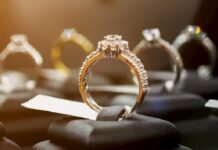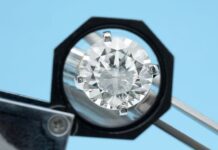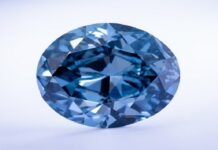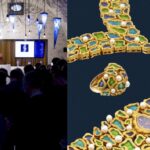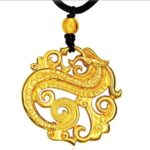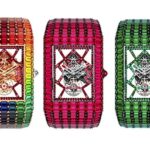Modern nuptials run the gamut from a rustic, outdoor woodland wedding to a colorful celebration in an exotic destination. Accordingly, engagement and wedding jewelry is becoming at once more varied and more personal.
Retailers say clients today want their purchases to be tailored precisely to their tastes and reflect their own personal aesthetic. This means that the bridal category is bucking tradition and letting its hair down.
New shapes, colors, and stones are giving the classic white gold, round-cut diamond solitaire engagement ring a run for its money. Designs and settings are more varied than ever, and even men’s jewelry is getting in on the trend.
“Everyone is looking for something superpersonal,” says Jennifer Gandia, co-owner of Greenwich St. Jewelers in New York City. “The amount of customization we do today is off the charts.”
Because so many consumers want unique jewels, retailers are learning that run-of-the-mill advertising no longer fits the bill. Instead, savvy jewelers are harnessing the power of social media to create marketing messages as precisely crafted as the jewelry itself. And since millennials’ budgets don’t always measure up to their aspirations, stores are finding ways to communicate that make them feel valued, encouraging lasting relationships.

Above: ring in 18k white gold with a 7.22 ct. oval-shape pink tourmaline and 1.3 cts. t.w. diamonds; $8,500; Omi Privé, West Covina, Calif.; 877-664-4367; omiprive.com
Mixed Metals, Modern Shapes
Jenny Chung, owner of No. 3 in San Francisco, says a foray into nontraditional bridal jewelry drew unexpected attention to her store. “It’s our biggest category and we never intended it to be, but there aren’t a lot of options for brides looking for something that’s not a classic solitaire.”
Color is in, she says: Sapphires of all shades are in demand, along with champagne, gray, and salt-and-pepper diamonds. These give a bride individuality and, quite often, a lower price point as well.
“Everybody wants to be unique,” says David Iler, co-owner of Alchemy in Portland, Ore. “Oftentimes, there are colored stones instead of diamonds being incorporated”—even fragile stones like opals.
In terms of shape, jewelers across the country report growing interest in engagement rings with pear-shape center stones, while settings featuring the ubiquitous halo are less in demand.
As for metal, that’s coming in all stripes—and colors.
“Rose gold has been very popular for us lately, and even yellow gold has been making a bit of a comeback,” says Scott Udell, vice president of London Jewelers and president of Two by London in Manhasset, N.Y.
“Maybe 20 percent of my bridal sales are yellow gold,” says Jonathan Tran, co-owner of H&Q Jewelers in Orlando, Fla. “Usually the yellow gold rings that sell are more on the vintage side.”
Men are responding to the durability and bold look—not to mention wallet-friendliness—of industrial metals. “I sell tungsten at least once a day,” Tran says. “When they feel the weight of the tungsten, they fall in love.”
Gandia sees more demand for elements like a hammered finish in men’s rings: “We’ve been selling a lot of texturized men’s bands. We have a couple of designers that are doing a lot of texture on a classic silhouette. It’s all done by hand so it feels unique and different.”

Chelsea ring (sold) and Elizabeth, Gabby, and Sadie bands in 18k rose gold with rose-cut and Old European–cut diamonds; $3,400–$8,000; Single Stone, Los Angeles; info@singlestone.com; singlestone.com
Marketing Evolves
Some retailers still swear by traditional marketing: Udell says he’s scored a home run with ads read by talk-radio hosts in his New York market, while Gandia says giveaways and partnerships with bloggers work for her business because they add a personal element to a campaign.
Events like trunk shows remain popular, Iler says, but these days he relies more on targeted digital advertising: “We were very print-ad focused 10 years ago—now it’s almost completely SEO [search engine optimization] focused. I do my own Google AdWords campaigns, and I customize and tweak that to the nth degree.”
And equally old-fashioned customer service is still an integral part of the mix once customers do walk through the door. Millennials can be maddening to retailers because they have all sorts of information at their fingertips but still crave figurative (or literal) handholding for big-ticket purchases such as engagement rings.
Jewelers say the key is communicating that they are there when those customers get offline and need the guidance of a real-life expert. “People typically want to choose their own stone, and that’s a high-touch element that’s harder to do online,” Chung says. “It’s the process—they want to be involved in the making of this ring.”

Ring in 14k yellow gold with 0.5 ct. rose-cut diamond and two pear-shape diamonds; $4,460; Jennie Kwon, Los Angeles; 213-221-7556; jenniekwondesigns.com
Messaging and (Social) Media
H&Q Jewelers’ Tran gets this. A millennial himself, he sees how real-life customer service translates into recognition via digital word of mouth. He touts his store’s many positive reviews on Yelp as being a major way for customers to find him, calling it the “biggest weapon” in his marketing arsenal.
Perhaps surprisingly, Tran says the positive reviews generally aren’t for pricey ring purchases but are more likely to be for repair jobs—an indication, he says, that when customers seek out a jewelry store for a bridal purchase, service and staff attention are top priorities.
Video is growing in popularity across all social channels because it increases the level of interactivity and gives customers a better sense of how a ring looks on a hand or how the stones sparkle. And while jewelers agree that a Facebook presence is a must, many get more traction from Instagram thanks to its emphasis on visuals.
“All we have is an Instagram and a Facebook page,” Chung says. “We don’t do any paid advertising. All we do is post pictures. That’s how our business was developed.”
Tone of voice is important in the social sphere, too. “We’ve all gotten a lot more casual,” Gandia says. “Social media has a very friendly lingo and vibe to it, so a lot of companies, even the ones that were at one time considered buttoned-up, have kind of relaxed a bit.”
That makes it easier for marketing messages to sound more like a dialogue and less like a sales pitch, jewelers say, an approach particularly appealing to millennials. “They’re very emotionally driven—sometimes something as simple as a funny or heartfelt quote or a story is what they connect with,” Gandia says. “When we get the most likes in a day or the most comments, we try to replicate that because our followers are telling us they’re engaged with this type of content.”

1.25 ct. rose-cut diamond engagement ring in 18k white gold, $7,800, matching bands in 18k rose gold, $960 each; Suneera, Los Angeles; ana@suneera.com; suneera.com
Money Matters
Budgets weigh on the minds of many millennial shoppers, store owners say. The savvy retailers are playing a long game: Working with young adults’ modest budgets and big ambitions might mean a smaller sale today, but the potential payoff from a lifelong customer is huge.
“Look, it’s a tough time of your life,” Udell says. “I’ve seen millennials who want to spend $5,000 or $6,000 on a setting, but they don’t have money for a center stone.”
For these customers, Udell offers a compromise—a quality, customized setting with a cubic zirconia until they can afford to return and replace it with a diamond. This option makes millennials feel like valued customers at the time, and opens the door to a longer relationship when they do have the money to replace the stone.
“Even if they can’t afford it then, what’s better than an anniversary present two or five years down the road?” Udell says. “It makes and keeps a special connection there—it’s really a form of marketing.”
To encourage sales, Two by London features a variety of financing options: The store has its own credit card and does twice-yearly deferred-interest promotions, as well as offering layaway. Its “Very Important Couple” program gives engagement-ring customers a 20 percent discount on wedding bands, plus access to the store’s cases so the bride can borrow a piece or two to add some sparkle to her wedding outfit.
“They obviously see the value in doing that,” Udell says, adding that the program turns browsers into satisfied and repeat customers.
Top: Photograph by Greg Sorensen, styling by Catherine Peridis
Market editor: Jennifer Heebner. Makeup by Alexis Williams for The Brooks Agency. Hair by Gusléne Bubak. Hair provided by Lo Bundles. Manicure by Jasmin Cameron. Dress by Theia.
Drop earrings in 18k gold with moonstones and diamonds, $48,400, Victor Velyan, Los Angeles, 213-955-5950, victorvelyan.com; Celebrations band in 18k yellow gold with colorless diamonds, $9,272, Mattioli, New Rochelle, N.Y., 914-235-6261, mattioligioielli.it; Ellen semi-mount in 18k gold with diamonds, $7,500, Erica Courtney, Los Angeles, 323-938-2373, ericacourtney.com
Inset: Petite Vertebrae ring in 18k gold with a 3.56 ct. emerald-cut red spinel and 1.64 cts. t.w. rubies; $37,200; K. Brunini Jewels, Solana Beach, Calif.; 858-259-8779; kbrunini.com
The Same Plan
Rather than marketing directly to gay and lesbian couples, many retailers rely on an eclectic merchandise mix and visibility in their local community. “I think when you’re trying to cater to a specific style or group, you’re limiting yourself,” says Alchemy’s David Iler. That said, jewelers do flag a few differences in how this population shops for wedding jewelry.

Ring with 1.91 ct. sapphire and 0.25 ct. t.w. pavé diamonds in recycled 18k gold, $9,950, blisslau.com
• Intertwining bands: No. 3’s Jenny Chung says bands that twine together but can be worn separately, such as Bliss Lau’s, are popular with her same-sex clientele.
• Less gender differentiation: “Sometimes I have a tough time” labeling a piece men’s or women’s when discussing it with a customer, says Greenwich St.’s Jennifer Gandia.
• More matching: Same-sex couples are likelier to opt for matching bands, jewelers say.
• Fewer big rocks: Chung says her same-sex clients gravitate toward designs and texture, not necessarily stones.
• Greater variety: Same-sex couples are less apt to go for a traditional bridal set, meaning options are key. “For us, it’s more about having a really good selection,” Gandia says. —MCW
– News Source : JCKOnlinecom
Disclaimer: This information has been collected through secondary research and TJM Media Pvt Ltd. is not responsible for any errors in the same.













